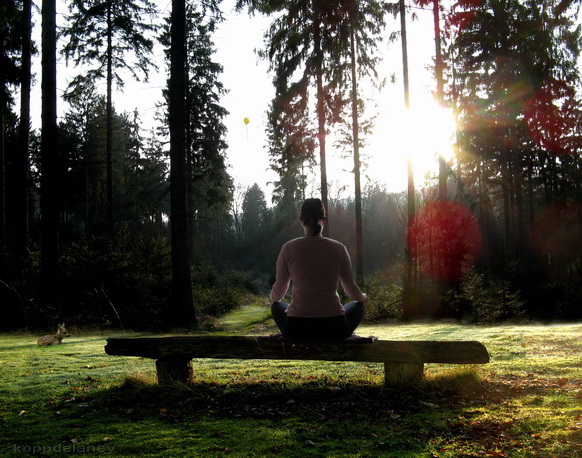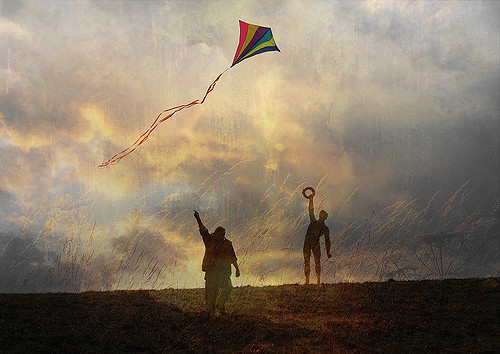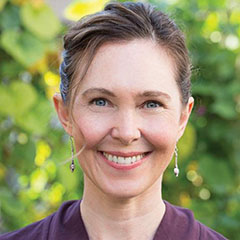Meditation Only Goes So Far (English)

If you want to connect with the open, spacious quality of mind, says Lama Willa Miller in her article about meditation, at some point you have to stop trying to meditate.
If you want to connect with the open, spacious quality of mind, says Lama Willa Miller, at some point you have to stop trying to meditate.
One hot summer evening several years ago, I found myself listening to a teaching in a meditation hall in upstate New York, an activity that had become far too rare at that point in my life. A hush came over the crowd as the diminutive teacher entered the room and took his seat. “Do you want to know the secret to meditation?” he asked.
Vigorous nods answered his question. Who doesn’t like to be in on a secret?
“Okay,” he said, “but first we need to prepare to meditate. Get comfortable on your cushion. Straighten your back. Lower your gaze. Relax your shoulders. Take a few slow, deep breaths…” He demonstrated.
There was a shuffle around the room as people shifted, pushed cushions into place, straightened up, sighed deeply. After a minute or so, the fidgeting settled.
“Okay, now—” The teacher paused for effect. “Listen closely. I am going to share a secret with you.” A palpable sense of anticipation settled over the room.
“Are you sure you’re ready?” He was teasing us a little. Glancing up, I could see that he was smiling, enjoying our expectation.
“All right. The secret to meditation is—”
He paused again to heighten our anticipation.
“Don’t meditate.”
He drew out the word “don’t” slowly.
After pausing again to let the instruction sink in, he added, “Instead, just be present, as you are, right here, right now. No grasping. Nothing more needs to be done.”
I’m not sure what others in the room experienced, but for me there was a sudden shift. I felt myself falling into a space of being acutely, vividly, and simply aware.

Dropping the Meditation Project
The instruction to not meditate may sound a bit scandalous in the Buddhist context we inhabit, but it is in fact nothing new. The hermeneutic of nonmeditation has roots as far back as the tenth century and the Indian master Tilopa, the founder of the Kagyu tradition of Tibetan Buddhism. He sings about non-meditation in his dohas (spiritual songs) and other instruction manuals. “Meditate alone in the forest and mountain retreats. Remain in the state of non-meditation,” he teaches in the Maha- rnudra Instruction to Naropa.
How can one meditate and not meditate at the same time? While it sounds like a paradox, it begins to make sense when you consider that non-meditation is a kind of meditation—but in this practice we leave behind complicated notions of what we are doing on the cushion. In non-meditation practice, there is no call to become extraordinary, no urge to change what is. Instead there is permission to accept your experience of the moment and drop the project of meditation.
Mahamudra, or “the great seal”—along with Dzogchen, “the great perfection”—is one of the simplest forms of meditation in the Tibetan tradition. In its most essential form, it is the art of just being. It is also one of the most difficult practices to successfully cultivate precisely because it is so simple.
We are naturally complex creatures, prone to taking a simple moment of experience—a sensory experience, a thought, or a feeling—and spinning a web of concepts around it. It is a real challenge, for example, to simply observe a thought without getting involved in its orbit. We tend to follow, resist, or judge our thoughts. Pretty soon, what started as a simple thought becomes a complex network of concepts and ideas accompanied by a swirling eddy of emotion and reactivity.
The same goes for our relationship to meditation. It is challenging for us to take a simple instruction such as “meditate on the breath every day” and just do it. Instead, we get involved in a vortex of thinking about the practice, framing the practice, resisting the practice, and comparing and judging our practice against a perceived ideal. Sometimes we even create a new identity around meditation practice. Whereas before we called ourselves a nurse, a teacher, a barista, or a jogger, now we are—in addition—a meditator, with all the self-concepts that accompany that label.
Meditation, in other words, is not only a practice; it is also a conceptual construct that carries weight in our life. That construct may have surprisingly little to do with the practice itself, yet we bring it with us as a subtle companion when we sit on the cushion.
In non-meditation, our projections, beliefs, and opinions are held lightly, and the vibrant space around and within them becomes the refuge.

The practice of non-meditation hastens recognition of this kind of conceptual baggage. It helps us see that concepts about what we are doing can sometimes inhibit the actual practice. When we drop the very thing we think we should be doing, suddenly the weight of everything we’ve been carrying becomes apparent. Ideas, we discover, can be heavy.
The instruction “Don’t meditate” invites us to shine a light around and through the construct of meditation. As we explore non-meditation as a way of being, we might even suspend our meditation practice for a while and cease to live by its rules. Meditation is a doorway to freedom, but it will always be a doorway, not the destination. When we drop the project of meditation and suspend allegiance to a construct, we can rest in our immediate experience, just as it is, free from the filter of interpretation. This is important, because immediate experience holds the key to our freedom.
Non-Meditation Practice
The first time I heard the term “non-meditation” was in 1987, in a packed room near Golden Gate Park in San Francisco, when Kalu Rinpoche introduced the “Three Gates to Liberation,” three key instructions on how to practice Mahamudra. They are not instructions for what to do but rather for what not to do. The practice, he told us, was this:
Do not fabricate
Do not meditate
Do not be distracted
In essence, Rinpoche explained, authentic practice is discovered when we let go and stop trying so hard. He taught that the heart of these three is nonmeditation, which involves the discovery of non- volitional space—a place where we drop striving and trust the fullness of what is already present.
When practicing non-meditation, we are not trying to accomplish a task or tether our mind to something, such as the breath. But we are not giving up either. So what are we doing? The short answer is that we are not doing—we are being. The initial task of non-meditation is to find a home in the present moment and let go of holding on to anything whatsoever. If there is a mantra of non-meditation, perhaps it is let go, let go, let go. We let go of intentions, schemes, expectations, projects, and grasping.
When we practice letting go again and again in this way, a spacious quality of mind that is naturally open and free emerges from the background of our consciousness into the foreground of our experience. If we can stay with the freshness of what is unfolding, aspects of our being conditioned by grasping and reactivity are gradually able to release.
Honing the skill of becoming a consummate nondoer does not mean becoming passive. It also does not mean our cognitive constructions—about meditation or anything else—vanish. Being, we discover, is not the antithesis of doing. Doing exists in the womb of being. So the practice of non-meditation is not so much an escape from constructions as it is a ‘ practice of noticing there is a great deal more to our experience than the constructions alone.
In non-meditation, our projections, beliefs, and opinions are held lightly, and the vibrant space around and within them becomes the refuge. In everyday life, we focus on the content of the mind’s activity. In non-meditation, we focus on the energy of the mind’s activity. From that vantage point, thoughts, ideas, beliefs, and so on are just pure dynamic energy, neither good nor bad, neither right nor wrong. When we notice this, we ease up on ourselves. We become more aware of the relativity of our thoughts and are able to disentangle ourselves from them, which enables us to be less reactive to whatever is happening, inside or out. We trust the energy of thought more than its content and can therefore have a sense of humor about the antics of our own mind.
We could publish this part of the orginal article with the friendly permission of the magazine „Lion’s Roar“.
=> Please continue to read this article on the website of Lion’s Roar.

Willa Miller
Willa Miller is a Buddhist teacher in Boston with the Natural Dharma Fellowship.


